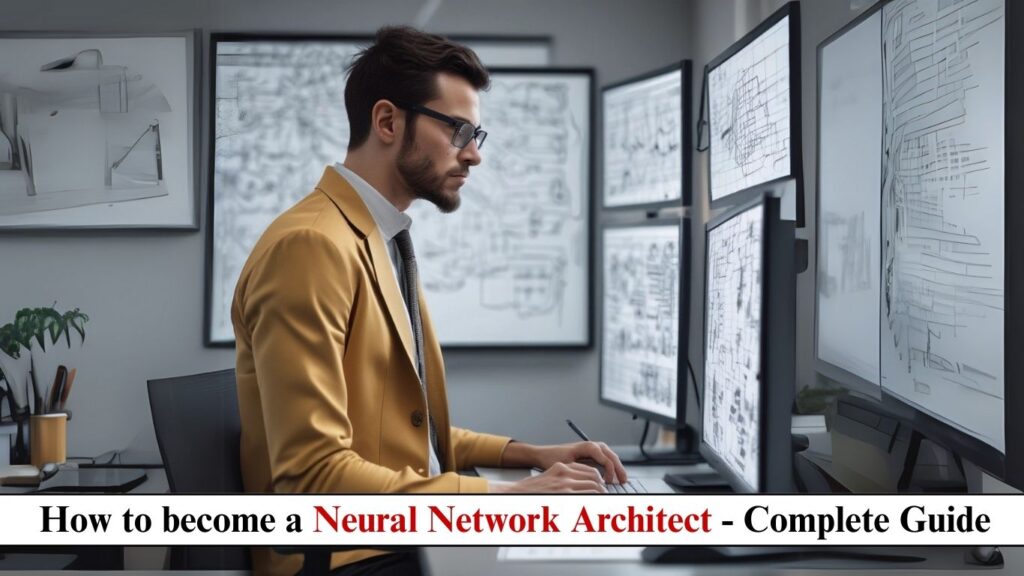
Introduction to Neural Network Architecture
The global deep learning market is projected to reach $526 billion by 2032, creating unprecedented demand for Neural Network Architects who design the AI systems powering everything from ChatGPT to self-driving cars. These elite professionals combine advanced mathematics, computer science, and domain expertise to create the next generation of intelligent systems.
This guide covers:
- Evolution of neural network architectures
- Salary benchmarks worldwide
- Core design responsibilities
- Required technical mastery
- Step-by-step career path
- Future industry trends
Whether you’re a machine learning engineer, researcher, or AI enthusiast, this guide reveals how to build world-class neural networks.
History of Neural Network Architectures
Foundational Era (1940s-1980s)
- 1943: McCulloch-Pitts neuron model
- 1958: Rosenblatt’s perceptron
- 1986: Backpropagation revolution (Rumelhart/Hinton)
Deep Learning Renaissance (2006-2014)
- 2006: Hinton’s deep belief networks
- 2012: AlexNet dominates ImageNet (GPU-powered CNN)
- 2014: GANs (Generative Adversarial Networks) invented
Modern Architectures (2015-Present)
- 2017: Transformer architecture (Vaswani et al.)
- 2020: GPT-3 demonstrates few-shot learning
- 2023: Mixture of Experts (MoE) models scale to trillions of parameters
- 2024: Liquid neural networks enable real-time robotics
Neural Network Architect Salary (2024)
| Experience Level | Average Salary (US) | Industry Variations |
|---|---|---|
| Entry-Level (0-2 yrs) | $120,000-$160,000 | +35% in autonomous vehicles |
| Mid-Career (3-5 yrs) | $160,000-$250,000 | +50% at AI research labs |
| Senior (5+ yrs) | $250,000-$500,000+ | +100% for MoE specialists |
Specialty Premiums:
- LLM architecture: +$75,000
- Neuromorphic design: +$50,000
- Edge AI optimization: +$40,000
Roles & Responsibilities
1. Architecture Design
- Develop novel neural topologies for specific tasks
- Optimize attention mechanisms (multi-head, flash attention)
- Design sparse expert networks for efficiency
2. Performance Optimization
- Implement quantization-aware training
- Develop neural architecture search (NAS) pipelines
- Create distributed training strategies
3. Domain Adaptation
- Customize architectures for:
- Computer vision (vision transformers)
- Natural language processing (causal/seq2seq)
- Reinforcement learning (decision transformers)
4. Research & Innovation
- Publish papers at NeurIPS/ICML
- Experiment with neurosymbolic hybrids
- Develop biologically plausible learning rules
5. Production Deployment
- Architect serving systems for:
- Low-latency inference
- Continuous learning
- Federated setups
Required Qualifications
Technical Skills Matrix
| Category | Essential Mastery |
|---|---|
| Mathematics | Linear algebra, calculus, probability |
| Frameworks | PyTorch, JAX, TensorFlow |
| Hardware | GPU/TPU optimization, CUDA |
| Architectures | Transformers, CNNs, RNNs, GANs |
| Optimization | Loss landscapes, gradient flow |
Certification Pathway
- Foundational:
- Deep Learning Specialization (Andrew Ng)
- NVIDIA DLI Architecture Cert
- Advanced:
- Google Brain Residency
- OpenAI Scholars Program
- Domain-Specific:
- LLM Architecture (Anthropic)
- Autonomous Systems (Tesla AI)
How to Get Started: 5-Step Roadmap
Step 1: Build Mathematical Foundations
- Master matrix calculus (backprop through layers)
- Study information theory (attention mechanisms)
- Complete Stanford CS231N/CS224N
Step 2: Develop Implementation Skills
- Reproduce papers from arXiv weekly
- Contribute to open-source frameworks
- Win Kaggle competitions with custom architectures
Step 3: Specialize Deeply
- High-Value Niches:
- Efficient transformers
- Neural differential equations
- Physics-informed networks
Step 4: Research Experience
- Publish at top-tier conferences
- Complete AI residency program
- File architecture patents
Step 5: Target Elite Employers
- Research Labs: DeepMind, FAIR, OpenAI
- Industry Leaders: NVIDIA, Tesla AI, Anthropic
- Startups: Inflection, Adept, Mistral
Future Scope & Trends
1. Architectural Breakthroughs
- 2025: 1 trillion parameter consumer devices
- 2027: Consciousness-inspired architectures
2. Emerging Applications
- Molecular discovery networks
- Real-time world models
- Brain-computer interfaces
3. Market Growth
- $1T AI chip market by 2030
- 100x increase in custom architectures
4. Career Innovations
- Chief Architecture Officers
- Neuro-AI Fusion Specialists
- AI Safety Architects
Conclusion: Is This Career Right For You?
✅ Ideal Candidate:
- Exceptional mathematical intuition
- Passion for fundamental research
- Comfort with extreme ambiguity
🚀 Action Plan:
- Achieve mastery of PyTorch internals
- Develop signature architectural innovation
- Network at AI engineering summits
- Specialize in next-gen paradigms
With every industry now requiring custom AI solutions, neural architects will remain the most valued professionals in tech.
Want our free neural architecture design templates? Comment below!
Questions about transitioning from software engineering? Ask here!













Post Comment